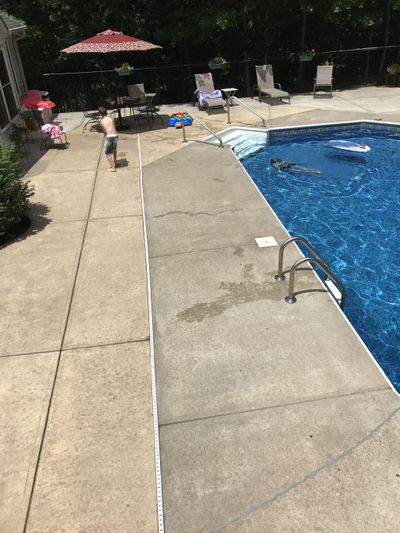Ask The Builder: Concrete stain can transform patio’s appearance

DEAR TIM: I’ve got an in-ground swimming pool at my home and my wife is not too happy about the concrete deck around the pool. The concrete was poured at different times and it’s cured to three different shades. She’s asked me what can be done to make the color uniform. Are there any affordable options? Is this something I can do myself? What are the pitfalls? – Mike D., Cincinnati
DEAR MIKE: What’s that old saying? A happy wife means a happy life. I’m about to crank up the happiness machine for you and her at the same time. You’re going to have to do a little work, but the end result is going to be stunning and long lasting.
You’ve got several options to transform your concrete’s appearance. The good news is one of the methods is very DIY friendly. This DIY method even allows you to drastically change the color of the concrete around your pool. My guess is your wife may not have thought about that, but it adds a dimension to the project that could make it the talk of the neighborhood.
Depending on how concrete is finished, it can have different levels of porosity. Based on the photos you sent me, I see you have a somewhat sandy finish that prevents slipping when the concrete is wet – and that’s good because the concrete is around your pool.
This sandy texture will work to your benefit if you decide to go with the easiest DIY solution I’ll talk about in a moment. But first let’s talk about staining your concrete. Believe it or not, you can buy special color stains that are made to soak into concrete. I’ve walked on stained concrete that looks like leather. Any imaginable color is possible. The look and appearance can be almost surreal when it’s done by pros.
The issue with staining sandy, porous concrete like yours is that the colors can become very deep, and it’s harder to achieve a multi-toned appearance that you’d get with concrete that’s got a surface texture that’s more like glass.
I mention this because you may discover that applying colored stain solves the problem immediately. Because you have distinct joints between the different slabs of concrete surrounding the pool, you can introduce different colors that complement one another. For example, the inner ring of concrete that touches up against the edge of the pool could be a tropical green while the outer ring could be a medium blue. You’re only limited by your imagination.
The concrete stains are tricky to work with; you have to follow instructions to the letter. If you decide to try this, it’s imperative to do a test on some concrete in another location to see if you like the color. This may require you pouring a new small pad of concrete that has the same texture as what’s around your pool.
My guess is you’re going to love your second option. There are concrete resurfacing products you can buy that you mix with water. Once mixed, they’re the consistency of applesauce. You simply spread the material on the existing concrete with a large squeegee and then apply a broom finish after waiting a few minutes.
These resurfacing products add a very thin layer of material onto the existing concrete, perhaps just 1/16 inch. The best part is you can add dry pigments to the mix to create a new colored surface. Reds, browns, greens, blues, golds, oranges and other hues are all possible. You can even create patterns with different colored mixes.
If you have an artist in the family, this talented person can create a mural on the pool deck using the resurfacing products and multiple colors. The possibilities are endless.
Your third option is to combine these resurfacing products with stencils. Using stencils and colored pigments in the mix, it’s possible to transform your bland concrete pool deck into a red brick look or even granite cobblestone. You can even get stencils that would transform the pool deck into a rich brown and gold flagstone.
Stenciled concrete is not DIY friendly, but the look is stunning. You may decide this is the best alternative for your pool area and it just requires you to locate a local professional that has lots of experience using stencils.
If you decide to go with the stenciled look, be sure to take the time to visit other jobs the professional has completed. Looking at photographs is not the same as seeing the finished job in person.
You asked about the pitfalls of the job. If you decide to do the concrete resurfacing yourself, I want you to test this process on a concrete slab other than your pool. You want to get the hang of how to use the product to get perfect results.
Don’t do the resurfacing on hot, sunny, breezy days. These are the worst possible conditions because the resurfacing compound dries too fast. It’s best to do this work on an overcast day with the temperatures around 60 F. This gives you plenty of time to work with the product, and you’ll get the best bond to the existing concrete. Be sure to read all the instructions and follow them with great diligence.
Need an answer? Carter’s past columns are archived for free at www.AsktheBuilder.com. You can also watch hundreds of videos, download Quick Start Guides and more, all for free.